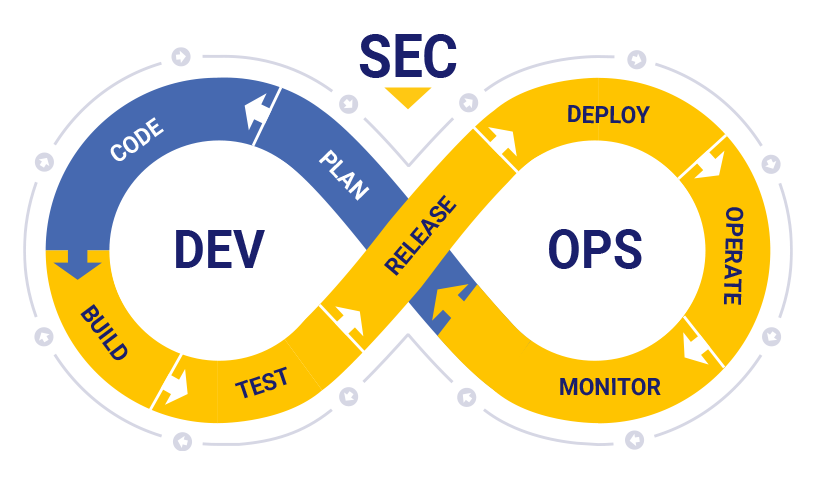DevOps is a software development practice that brings software development (dev) and IT operations (ops) teams together. DevSecOps adds a security layer to DevOps.
DevOps (a portmanteau of “development” and “operations”) refers to the combination of practices and tools that help organizations enhance their capability to build and deliver software applications and services efficiently and faster than conventional software development and infrastructure management processes. It allows the two teams in organizations to effectively collaborate, communicate, and be transparent to build software at a lesser time and cost and still remain flexible to changes.
DevSecOps (short for development, security, and operations) is a replication of DevOps that borrows the latter’s model and adds security as an extra layer to it. The philosophy of DevSecOps brings development, security, and operations teams together in order to deliver the software to production faster while ensuring the application is secure from vulnerabilities from the initial stage of development.
Key Terminology:
- DevOps is an emerging software development practice that combines development and operations and DevSecOps adds security as an additional layer to DevOps
- DevSecOps helps organizations save time and cost in fixing vulnerabilities leading to improvement in productivity and efficiency in the total application development cycle
- DevSecOps is increasingly attracting attention from CIOs and CTOs because of the rising incidents of cyber threats that could be detrimental to organizations
The increasing interest of organizations in DevSecOps can be gauged from studies that project its market grow to USD 41.66 Billion by 2030, at a CAGR of 30.76% between 2022 and 2030. Most companies are accelerating the adoption of DevSecOps, with about 27 percent of respondents reporting they are in the advanced stage of its adoption and 50 percent in the early stages.
The question: Why should an organization and its CIO care about DevSecOps and what value it brings to software development? Let’s take a look.
Understanding DevSecOps
In place of the traditional practice of considering security as a separate component, under DevSecOps practice security is an integral part of the software development cycle. The security team continuously tests the software as part of the software development process before releasing the application to make the code free of security vulnerabilities. The practice teams use tools and processes to facilitate collaboration between developers, security, and operation teams to build efficient and secure software, helping position security as a shared responsibility for everyone who is part of the project team.
The DevSecOps culture combines communication, people, technology, and process. Communication of the change starts at the top, with senior leaders explaining to the teams the importance and benefits of adopting DevSecOps practice. The practice also involves the use of technology tools to track, monitor, and deploy the security component in the product development process. Process is the most critical element in DevSecOps culture and it ensures that testing security and checking for security flaws are done at every stage of development and even after the application goes live.
Why Organizations Should Care About DevSecOps
The reason organizations and their CIOs and CTOs should care about DevSecOps is that it can help organizations improve the security of the software while also reducing the time it takes to get code from development into production. Security which is a massive issue in the software industry can be addressed with the adoption of DevSecOps to respond to security threats more quickly and with less downtime.
The reasons why organizations should adopt DevSecOps include the following key factors:
- Time and Cost Savings: Since DevSecOps incorporates security and testing into the development process, it helps the teams identify and address issues earlier, reducing the time and cost of fixing them later.
- Early Checks: Under DevSecOps, security and monitoring become part of the development process from the beginning. This ensures that the application is secure and stable throughout the development cycle.
- Transparency: The culture of collaboration and open communication between teams brings transparency from the start of development.
- Measurability: DevSecOps promotes a “secure by design” approach, where security is integrated into every stage and aspect of development, which makes the measurement of security metrics a priority.
- Quicker Recovery: In the event of a security threat, DevSecOps allows for quicker recovery time as security measures are already in place.
- Improved Security: DevSecOps enables the use of immutable infrastructure and security automation, resulting in a better overall security posture.
- Compliance: DevSecOps helps teams identify data protection and security regulations of the countries their application will be used and ensure they are incorporated in the application.
- Security Awareness: DevSecOps also promotes a security-aware culture within the software teams by making them proactively identify potential security issues in the code and other technologies that are used for development.
DevSecOps is a win-win for both development and security teams. In traditional software development methodologies, security testing was a separate process from the SDLC and therefore the security flaws could be detected only after the application was built.
How to get started with DevSecOps
Organizations and their CIOs and CTOs must embrace the best approach to initiate the adoption of DevSecOps based on the size and needs of the organization. Let us go over a few tips on how to get started:
- Assess Current State: It starts with the step includes assessing how the software is currently developed and how secure it is, using tools, such as vulnerability scanners or security assessments.
- Cultural Change: This step includes developing a model, which describes what tools and resources will be needed in the development process and how they will be used. It also includes designing and implementing processes and practices, such as continuous integration/continuous distribution (CI/CD).
- DevSecOps Techniques: The next step is to start implementing the tools and processes to embrace the cultural changes. Best DevSecOps practices include adopting automated testing and deploying software using containers or microservices.
- Monitor and Measure: It is important that adopted DevSecOps techniques are monitored, measured, and improved on a continuous basis. This is achieved by tracking the performance of automated testing and measuring the security of the application.
Ending Note
DevSecOps is gaining unprecedented interest from software development teams. This is more so for those companies developing applications that will be hosted and accessed online over the internet, which makes them more vulnerable to threats. This should be read with the statistics that predict global cybercrime damages to cost up to $10.5 trillion annually by 2025 (Cybersecurity Ventures). According to another research, the global estimated cost of cybercrime is forecast to reach $13.82 trillion by 2028. CIOs and small organizations that consider security a top priority must explore ways to get help to adopt DevSecOps in their organizations, to avoid surprises and incurring losses and customers.




